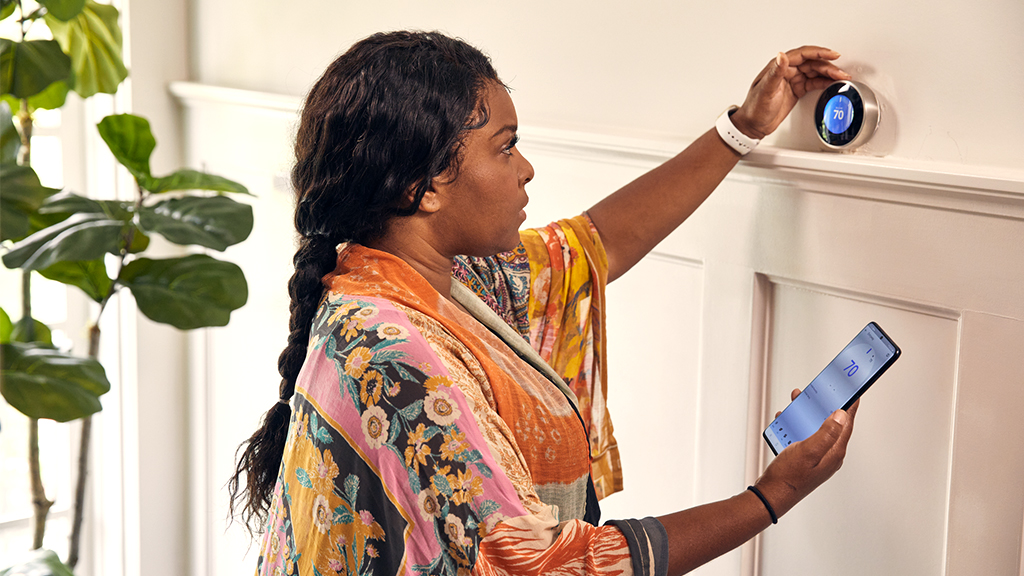From light bulbs that turn themselves off to thermostats that adjust when you're out, smart home devices add a little bit of magic to your home. But they can also save you money, reduce energy usage, and help protect the environment.
Every year, American homes and businesses waste around $130 billion on energy, according to The Energy Resource Center, a Colorado-based non-profit. With more people working remotely after to the COVID-19 pandemic, the average household could spend up to $5 a day (or about $100 a month) on additional energy costs, according to one study.
Wouldn't it be great to reduce your electricity bill—and help the planet? It's simple. We'll show you how. At Asurion, we teach you how to get the most out of your tech, whether you want to speed up a slow phone or discover fun things to ask your virtual assistant. Here's our guide to how to save money and electricity with smart home devices.
What are smart home devices?
These gadgets connect to your home internet, letting you control them from your smartphone, tablet, or via voice command on your Google Assistant™, Amazon Alexa™, or other smart home hubs. So whether you're across the street or on a cruise, you can lower the heat a couple degrees, boost your AC during warm weather, turn off the lights, or even monitor your sprinkler system—as long as you're connected to the web.

Psst... Got 2 minutes?
That’s how long it takes to get a care plan personalized for you:
✓ Coverage for thousands of devices ✓ Fast, quality fixes
✓ Hands-on help when you need it
4 smart home devices that can help lower your electric bill
These days, nearly everything in our homes seems to connect to the internet. But what are the best energy-and money-saving devices for your smart home? Here are four gadgets our experts swear by.
Smart thermostats
Are smart thermostats really worth it? Absolutely. These programmable thermostats let you remotely control your home's climate, learn your schedule, and adjust to energy-saving settings when no one is home or you're asleep.
They're also affordable: Smart thermostats range from $100–200 in cost—some are more, but most people make up that cost within a year or two. House size, occupancy, and location are among the factors that affect how much money and energy you save. According to Google®, its Nest™ product saves 10–15% on heating and cooling, with an average savings of $131–145 a year on utility bills. Ecobee® says customers save as much as 26% on heating and cooling costs. And Energy Star® says their smart thermostats cut your utility cost by around 8%, or $50 a year.
In terms of compatibility, most American homes have a forced-air furnace system or a heat pump, both of which work well with the smart thermostats on the market. However, not all heating systems are compatible, and if you have hydronic heating (like steam, hot water, or radiant underfloor), you may not see huge savings. Head to your HVAC brand's website and look at the compatibility checker to confirm.
To learn more, listen to our experts discuss what smart thermostats can do.
Smart light bulbs
Growing up, your parents probably told you to turn off the lights when you went to bed at night to reduce energy consumption, but nowadays you can turn them off anytime, from anywhere. Smart lights are LED light bulbs that make your home more energy-efficient, letting you control your lighting from anywhere and set up schedules.
Smart lights can also save you money. According to the Department of Energy, these bulbs last 25 times longer and use at least 75% less energy than incandescent bulbs. Depending on the brand and number of smart bulbs you're buying, they typically range in cost from $10–50.
Ready to change your light fixtures? Here's our guide to smart lights and a how-to video on syncing your lights to music.
Smart plugs
Another low-cost way to lower your energy bill is with smart plugs. These devices automate the tech in your home, allowing you to turn off your coffee maker, TV, or window AC unit when you don't need them by simply tapping your phone or using a voice command. All you need to do is set up your smart plug correctly, and make sure it's connected to Wi-Fi. The small amount of money you'll save adds up over time. Cool, right?
Smart sprinkler system
One final energy-smart trick comes with an added bonus: a better-looking lawn.
A smart sprinkler system uses weather data and in-ground moisture sensors to determine when your sprinklers need to run, reducing water use and saving you money along the way. Since the tech connects to your phone through an app, it's easy to customize by off-peak hours or turn off the sprinklers when you pick up the morning paper.
A smart sprinkler system usually costs $100–300 and requires a strong Wi-Fi connection as well as a wired, underground irrigation system. But if you already have the latter, smart sprinklers are worth it and can pay you back over time. According to the EPA, the average home can save nearly 7,600 gallons of water every year with a WaterSense®-certified smart sprinkler.
Make sure your smart home is protected
An Asurion Home+® protection plan provides coverage for nearly all the technology in your home with one simple plan. Laptops, tablets, TVs, gaming consoles, smart thermostats, and so much more—even future purchases. Plus, you'll get 24/7 live expert support and robust digital security. Learn more about Asurion Home+® coverage and how you can get peace-of-mind electronics protection.





